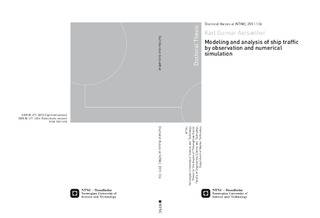| dc.contributor.author | Aarsæther, Karl Gunnar | nb_NO |
| dc.date.accessioned | 2014-12-19T12:06:47Z | |
| dc.date.available | 2014-12-19T12:06:47Z | |
| dc.date.created | 2012-01-23 | nb_NO |
| dc.date.issued | 2011 | nb_NO |
| dc.identifier | 501405 | nb_NO |
| dc.identifier.isbn | 82-471-2813-8 (printed version) | nb_NO |
| dc.identifier.isbn | 82-471-2814-5 (electronic version) | nb_NO |
| dc.identifier.uri | http://hdl.handle.net/11250/238004 | |
| dc.description.abstract | The continuing losses of vessels and the ever increasing volume of cargo carried by ship marks marine traffic as a high risk activity where a single accident has the potential to incur large human, environmental and economic losses. Collision and grounding contributes a significant portion of the total number of accidents at sea and are a manifestation of the fundamental situation where by vessels are at the wrong place at the wrong time. In order to quantify the probability of these unfortunate events one can turn to either observation or simulation, but observation has previously been limited by the difficulties in observing ship traffic, while simulations with bridge simulators are time consuming and expensive.
The Automatic Identification System (AIS) for ships was introduced as an real-time monitoring system which would augment ship-borne radar and monitoring by Vessel Traffic Services, but may also be used as an convenient method of observation of ship traffic with position and speed measurements from uniquely identified ships. The data available form the system can then be used to estimate the probability of a vessel being in the wrong place at the wrong time if a method to analyze the data is available. This thesis presents a method to process the raw AIS data into a format which both eases analysis and allows for a fine grained analysis of traffic patterns. The method can be used to:
1. Detect regional traffic patterns
2. Collect AIS sample into per voyage time-series and attach the time-series to a traffic pattern
3. Analyze the traffic patterns and generate an approximate simplified navigational plan which can be connected to the navigational markers in the area
The use of observed data can be used to estimate the probability of accidents or dangerous situations occurring during normal operation, but simulations continue to be the preferred tool to represent out-of-the-ordinary scenarios. The human element, be it operation or design, are identified as the root cause of the majority of incidents and accidents. The use of human-in-the-loop simulations has secured the relevance of simulation as a tool for risk analysis of maritime traffic, but the resource requirements and constraints of the human operator has limited the application of simulation. This thesis presents a simulation model intended for use in autonomous and efficient time-domain simulations which can be used on regular workstations in order to undertake preliminary simulation studies of marine traffic to either deliver estimates or as a screening procedure before undertaking the more expensive simulations with a human operator. | nb_NO |
| dc.language | eng | nb_NO |
| dc.publisher | Norges teknisk-naturvitenskapelige universitet, Fakultet for ingeniørvitenskap og teknologi, Institutt for marin teknikk | nb_NO |
| dc.relation.ispartofseries | Doktoravhandlinger ved NTNU, 1503-8181; 2011:136 | nb_NO |
| dc.relation.haspart | Aarsæther, Karl Gunnar; Moan, Torgeir. Combined Maneuvering Analysis, AIS and Full-Mission Simulation. 7th International NavigationalSymposium on Marine Navigation and Safety of Sea Transportation, Gdynia, Poland 2007Main papers, 2007. | nb_NO |
| dc.relation.haspart | Aarsæther, Karl Gunnar; Moan, Torgeir. Autonomous Ship Traffic Model for Ship Maneuvering Simulations Based on Historical Data. Proceedings of the 7th international conference on computersapplications and information technologies in the maritime industries (COMPIT 08): 372-383, 2008. | nb_NO |
| dc.relation.haspart | Aarsæther, K. G.; Moan, T.. Computer Vision and Ship Traffic Analysis: Inferring Maneuver Patterns From theAutomatic Identification System. Proceedings of the 8th international symposium on navigation 2009: 177-182, 2009. | nb_NO |
| dc.title | Modeling and analysis of ship traffic by observation and numerical simulation | nb_NO |
| dc.type | Doctoral thesis | nb_NO |
| dc.contributor.department | Norges teknisk-naturvitenskapelige universitet, Fakultet for ingeniørvitenskap og teknologi, Institutt for marin teknikk | nb_NO |
| dc.description.degree | PhD i marin teknikk | nb_NO |
| dc.description.degree | PhD in Marine Technology | en_GB |
